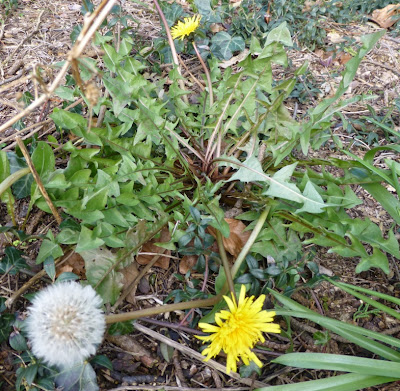Fatal Flowers?
A sudden outburst of flowers in the sunshine is telling me that spring is on the way, especially the cheeky dandelions flowering earlier than usual. Just look at that seed head ready to invade the garden, and it’s only mid-February.
Now there’s
one flower which will be soon be making an appearance and from what I heard at a
recent meeting on the theme of ‘Environmental Aspects of the River Otter’,
organised by the Otter Valley Association it’s even more cheeky and persistent
than dandelions. For wildlife trusts it’s actually one of the most worrying
sights anywhere in the countryside.
Just imagine
some scientist telling us that cancer spores could be cleared up as easily as
litter from our streets and hedgerows in order to totally eradicate that
horrible disease. Think of the national effort that would be made as everyone
scoured streets and pavements, our woods, fields and river-banks. From the
tiniest toddler to the most wrinkled granny we’d all be out there on hands and
knees if necessary making sure that not one speck or molecule remained. Within a day or so cancer would be a thing of
the past.

Well, on
Saturday 16 February I learnt from Roland Stonex, one of four speakers at the
event, about the Otter Valley Himalayan Balsam Project 2012 and about the
flower that he says is becoming a national plague.
Homily with a Himalayan
theme: Roland Stonex explains what he sees as the menace of Himalayan balsam
Roland works for FWAG SW (Farming
and Wildlife Advisory Group), a charity set up in the 1960s by farmers to promote
the environmental dimension of farming. FWAG SW has over 2,000 farmer members
in an area stretching from Cornwall Otter
Valley

A baneful beauty? The flower of Himalayan balsam
Himalayan balsam (Impatiens glandulifera),
according to many experts, is as deadly as cancer as far as our fragile wildflower ecology is
concerned. It has the ability to grow in
low levels of light and is able to shade
out other vegetation, so gradually impoverishing habitats by killing off other
plants. As an annual, Himalayan balsam dies back in the winter.
That’s when its damage to river banks can best be observed as the plant leaves
them bare of vegetation and liable to erosion.
The plant
was apparently introduced into Britain England

Bluebells under threat
Image credit: Ramin Nakisa
It’s not
just river-banks that it frequents. There is evidence that the plants are
invading our woodlands, with seeds carried along favourite footpaths by
walkers’ feet and even spread by the tyres of tractors. Those much-loved vistas
of bluebells could become a distant memory.
Now not
everyone hates Himalayan balsam. A Peter Herring who
has contributed a fine photo of the flowers to Flikr tells us that it is “one of my favourite plants, but
hated by conservationists who organise balsam bashing jollies.”
The plant,
he writes, is an annual and so is not permanent. “Its seeds float down river
and so will colonise slow moving waterways, but they cannot flow upstream so
why the paranoia? Great fun can be had by touching the ripe seed pods. They
explode sending seed shrapnel over a wide area. The seed strikes other pods and
they explode in turn setting up a chain reaction.”
That does
sound as much fun as the tradition enjoyed by children of all ages blowing
dandelion seeds into the wind.
I don’t
know where Peter Herring lives, but nearer home the wild food enthusiasts Chris
Holland and Robin Harford who have organised many weed gathering expeditions
along the Otter’s river banks praise Himalayan balsam. Robin
tells us that the plant has been eaten in India
Chris’s own
website is at http://www.wholeland.org.uk/about/
Bob
Wiltshire of the Otter Valley Association was standing at the door of St
Peter’s Church as we left the meeting and my friend Annie and I were quickly
recruited as balsam bashers. Well, pulling up a few thousand of these blighters
by the roots would be an easy job and it might be worth a day’s jolly or two
just to see if our efforts resulted in the revival of some equally beautiful
but more fragile wild flowers in their place. I might even take some stems home
to try out that curry, to which I’m rather partial.






Some control of Himalayan balsam is necessary but please don't forget that it is fantastic for honey bees. It has a very high nectar content and flowers late when many other plants have finished. This late foraging makes excellent honey and helps to take the bees through the winter. If you want to help save the bees don't destroy all the balsam. Bracken is far worse - and it's carcinogenic.
ReplyDelete